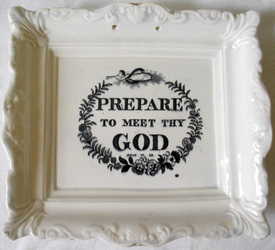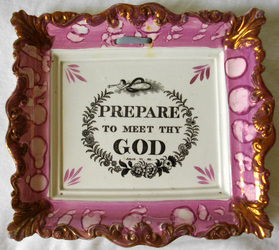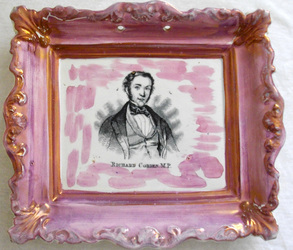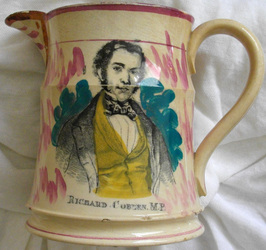|
5/27/2011 0 Comments John Carr and Richard CobdenUpdate, February 2023... I don't generally update my blog posts retrospectively, and my thoughts have moved on considerably in the last 12 years. Please see here, for my latest attribution of the Richard Cobden transfer. Ian Holmes, the owner of the pink plaque below, which appears in my May 23 posting, has taken another look at it. And guess what? It too has a John Carr & Sons impressed mark. So it isn't Middlesbrough after all. Ian suggests that the white plaque, which has a blurred transfer, was a factory second, and therefore not considered worth decorating with lustre. This accords with one or two of my all-white plaques, which have obvious manufacturing flaws. So what of the 'For man dieth' plaque below? It is of an identical form, with a transfer clearly from the same set of plates, but has a mark that appears on items of Middlesbrough pottery. The lustre is much more purple, but interestingly has worn in the same way. Below right is an unmarked 'Prepare' plaque from the same plate as those above, but with a purple border. There are at least two possibilities. Firstly, that these plaques were originally made in Middlesbrough, and then production moved to John Carr's pottery in North Shields. And secondly, that these plaques were all made by John Carr, and that the 'London' mark above was used by several potteries to designate items for a particular London distributor. The first plaque below has a transfer from the same plate. As discussed in my May 23 posting, it is of a larger size (21.9 x 24.0 cm). It is also much better quality than the plaques above, and certainly pre-dates them (this is evidenced by additional spots and scratches, acquired over time, which appear on the Carr transfers, but not on this earlier imprint). I think this plaque is c1840s, and the Carr plaques are post 1861. If we could work out where the plaque below came from, then we might be a step closer to sorting things out. Interestingly, Richard Cobden appears on this larger plaque form (21.9 x 24.1 cm). So a likely date is 1846 when the corn laws were repealed. If we look at the plaque forms with Cobden, can they tell us where these larger plaques were produced? The first plaque below is the large plaque form we're trying to attribute. The second is of a form attributed to Scott of Southwick. The third and fourth are from an unknown pottery on a larger-than-average size plaque form (20.7 x 23.5 cm), but smaller than the first plaque. Confusion abounds. I would rather have believed they were from two different transfer plates, but they aren't. Transfer plates often contained several different transfers. They were printed onto tissue paper and the relevant bits cut out and applied to the pottery. In this case there are snippets of what appear to be the tips of leaves or petals left behind from other transfers surrounding Cobden on the transfer plate. In the second details of the first two plaques, note the curly mark to the top left. In the last three plaques, note the mark to the left of Cobden's left ear. So the only positive ID is for the Scott-attributed plaque, made in Sunderland. So not Middlesbrough, or North Shields (Carr). Ian Holmes has thrown one more item into the mix. A jug attributed to Carr. The jug has a verse on one side that also appears on Scott-attributed plaques (below right). The jug is crudely decorated and potted. Ian suggests that it might have been made in 1865 (which fits in with the Carr attribution) to commemorate Cobden's death. So we're really no closer to identifying the origin of the larger plaques. Though we've at least established another link between them and Carr. Could Carr have made them? My feeling is that Scott's small rectangular plaques, which are finest in decoration, were made first. Cobden's work as a peace campaigner caused him to quickly fall out of favour and he was ridiculed by the press (see http://en.wikipedia.org/wiki/Richard_Cobden). His crashing fall from public popularity would explain why Scott sold the transfer plate. Looking at the crude decoration of the last two plaques, which is similar to that on the jug, it is possible they were made in the 1860s by Carr. I'm still not sure that's true for the first, larger-sized plaque, which looks to be finer. And I don't think the larger plaques were made by Scott either. Scott's Soutwick Pottery bought up the common religious verse transfer plates with such zeal, that it is hard to imagine them selling on a whole set to Carr. The best I can say is that perhaps these larger plaques were produced a bit later than I'd first supposed.
All answers on the back of a postcard please.
0 Comments
Leave a Reply. |
AuthorStephen Smith lives in London, and is always happy to hear from other collectors. If you have an interesting collection of plaques, and are based in the UK, he will photograph them for you. Free advice given regarding selling and dispersal of a collection, or to those wishing to start one. Just get in touch... Archives
February 2022
AcknowledgementsThis website is indebted to collectors, dealers and enthusiasts who have shared their knowledge or photos. In particular: Ian Holmes, Stephen Duckworth, Dick Henrywood, Norman Lowe, Keith Lovell, Donald H Ryan, Harold Crowder, Jack and Joyce Cockerill, Myrna Schkolne, Elinor Penna, Ian Sharp, Shauna Gregg at the Sunderland Museum, Keith Bell, Martyn Edgell, and Liz Denton.
|

























